Evolution of Microstructure and Crystallographic Texture in Deformed and Annealed BCC Metals and Alloys: A Review
Abstract
1. Introduction
2. Beta-Ti Alloys
2.1. Deformed Microstructure and Texture Evolution
2.2. Heat-Treated Microstructure and Texture Evolution
3. Tantalum and Its Alloys
3.1. Deformed Microstructure and Texture Evolution
3.2. Heat-Treated Microstructure and Texture Evolution
4. Ferritic Stainless Steels
4.1. Deformed Microstructure and Texture Evolution
4.2. Heat-Treated Microstructure and Texture Evolution
5. Discussion
5.1. Slip and Twin Deformation in β-Ti Alloys
5.2. Schmid Factor (SF) and Ta Alloys
5.3. Ridging in FSSs
6. Conclusions
- SIM (α″/α′), SBs, deformation induced ω, and mechanical twins are typical deformation-induced products that form during the plastic deformation of β-Ti alloys. The density of these products increases during plastic deformation, serving as an additional deformation mode. The evolution of α (αGB, αWGB, transgranular α) and ω (isothermal and athermal) depends on the heating temperature range and cooling rate. The α-phase, isothermal ω and athermal ω phases precipitate during low-temperature heat treatment and quenching, respectively. The development of crystallographic texture in cold-rolled β-Ti alloys typically shows the evolution of α- and γ-fiber texture components. Furthermore, hot rolling contributes to the formation of DRX grains, which diminish the strength of the texture. During hot deformation, grain boundary serrations contribute to DDRX, while the progressive rotation of subgrains suggests the CDRX mechanism.
- The rolling texture of Ta and Ta-W alloys results in the formation of α- and γ-fiber. The homogeneous distribution of through-thickness orientations depends on the rolling strain path. Clock rolling leads to a homogenous texture through thickness compared to UDR. With the addition of W in varying contents, the development of texture in Ta-W alloys differs from pure Ta as various slip systems are activated with the varied W content. The Schmid factor (SF) shows orientation dependency in individual grains of deformed Ta and Ta-W alloys. In particular, in the center region, the {111} matrix exhibits a significantly higher SF, while the {110} matrix exhibits a relatively lower SF. This SF difference is due to varying concentrations of shear deformation within the {111} and {110} substructures. Higher orientation gradients in {111} grains were observed in pure Ta, attributed to the evolution of micro-SBs. In Ta-2.5W, {111}<112> oriented grains exhibited a higher intensity of SBs compared to {112}<110>-oriented grains.
- The microstructures of the FSS-rolled sheets consist of elongated ferrite grains and in-grain SBs, with a preference for γ-fiber orientation. The CR texture of FSSs typically results in the formation of strong α- and weak γ-fiber. Grain size plays a significant role in rolling texture evolution, as a more intense γ-fiber is formed in fine-grained CR samples compared to coarse-grained CR samples. Upon annealing FSSs, a strong γ-fiber forms. Intermediate annealing leads to the formation of uniform γ-fiber textures and a more homogeneous distribution of grain colonies. This intermediate annealing also aids in resisting the phenomenon of ridging. The {111} recrystallization texture significantly reduces ridging and is beneficial for the formability of FSSs. The formation of the intermetallics such as σ, χ, and Laves phases occurs at a temperature range of 600–1000 °C in Nb- and Ti-stabilized FSSs.
Author Contributions
Funding
Data Availability Statement
Conflicts of Interest
Abbreviations
References
- Kim, M.-S.; Kim, J.G.; Kwon, S.-C.; Jeong, D.H.; Lee, S.; Jeong, H.-T.; Choi, S.-H. Evolution of the Microstructure and Mechanical Properties of Interstitial-Free Steel during Multi-Axial Diagonal Forging. Mater. Sci. Eng. A 2022, 846, 143242. [Google Scholar] [CrossRef]
- Baton, J.; Geslin, W.; Moussa, C. Influence of Crystallographic Orientation on the Recrystallization of Pure Tantalum through Microstructure-Based Estimation of the Stored Energy. Int. J. Refract. Met. Hard Mater. 2022, 104, 105786. [Google Scholar] [CrossRef]
- Zhu, J.; Liu, S.; Yuan, X.; Liu, Q. Comparing the Through-Thickness Gradient of the Deformed and Recrystallized Microstructure in Tantalum with Unidirectional and Clock Rolling. Materials 2019, 12, 169. [Google Scholar] [CrossRef] [PubMed]
- Fan, H.; Liu, S.; Deng, C.; Wu, X.; Cao, L.; Liu, Q. Quantitative Analysis: How Annealing Temperature Influences Recrystallization Texture and Grain Shape in Tantalum. Int. J. Refract. Met. Hard Mater. 2018, 72, 244–252. [Google Scholar] [CrossRef]
- Gupta, A.; Khatirkar, R.K.; Dandekar, T.; Mahadule, D. Texture Development during Multi-Step cross Rolling of a β Titanium Alloy: Experiments and Simulations. J. Alloys Compd. 2023, 850, 156824. [Google Scholar] [CrossRef]
- Zhu, C.; Zhang, X.Y.; Li, C.; Liu, C.; Zhou, K. A Strengthening Strategy for Metastable β Titanium Alloys: Synergy Effect of Primary α Phase and β Phase Stability. Mater. Sci. Eng. A 2022, 852, 143736. [Google Scholar] [CrossRef]
- Wang, M.; Jiang, Y.; Li, Z.; Xiao, Z.; Gong, S.; Qiu, W.; Lei, Q. Microstructure Evolution and Deformation Behaviour of Cu-10 Wt%Fe Alloy during Cold Rolling. Mater. Sci. Eng. A 2021, 801, 140379. [Google Scholar] [CrossRef]
- Mahadule, D.; Khatirkar, R.K.; Gupta, A.; Kumar, R. Effect of Heating Temperature and Cooling Rate on the Microstructure and Mechanical Properties of a Mo-Rich Two Phase α + β Titanium Alloy. J. Mater. Res. 2021, 36, 751–763. [Google Scholar] [CrossRef]
- Li, M.; Min, X. Origin of ω-Phase Formation in Metastable β-Type Ti-Mo Alloys: Cluster Structure and Stacking Fault. Sci. Rep. 2020, 10, 8664. [Google Scholar] [CrossRef]
- Shao, B.; Wang, J.; Tang, W.; Huang, S.; Zong, Y.; Shan, D.; Guo, B. Microstructural Evolution and Slip during Yielding in Ti-5Al-5V-2Mo-2Cr Alloy. J. Alloys Compd. 2023, 945, 169269. [Google Scholar] [CrossRef]
- Sim, J.-J.; Choi, S.-H.; Lee, Y.-K.; Heo, S.G.; Kim, T.-S.; Seo, S.-J.; Park, K.-T. Consideration of Diluents Selection and Input Amounts of the Hunter Process for Tantalum Production. Met. Mater. Int. 2021, 27, 1980–1987. [Google Scholar] [CrossRef]
- Pegel, B. Stacking Faults on {110} Planes in the B.C.C. Lattice. Phys. Status Solidi 1968, 28, 603–609. [Google Scholar] [CrossRef]
- Tang, Y.; Liu, Y.; Peng, Y.; Xiong, W.; Long, J.; Tan, D. Dynamic Restoration and Texture Evolution of Pure Tantalum during Warm Deformation. Int. J. Refract. Met. Hard Mater. 2023, 115, 106279. [Google Scholar] [CrossRef]
- Song, C.; Deng, Z.; Chen, J.; Yang, Z.; Zou, Z.; Liu, L.; Yang, Y.; Xu, K.; Wang, J. Study on the Influence of Oxygen Content Evolution on the Mechanical Properties of Tantalum Powder Fabricated by Laser Powder Bed Fusion. Mater. Charact. 2023, 205, 113235. [Google Scholar] [CrossRef]
- Stelmakh, V.; Rinnerbauer, V.; Geil, R.D.; Aimone, P.R.; Senkevich, J.J.; Joannopoulos, J.D.; Soljačić, M.; Celanovic, I. High-Temperature Tantalum Tungsten Alloy Photonic Crystals: Stability, Optical Properties, and Fabrication. Appl. Phys. Lett. 2013, 103. [Google Scholar] [CrossRef]
- Jakubowicz, J.; Adamek, G.; Sopata, M.; Koper, J.K.; Kachlicki, T.; Jarzebski, M. Microstructure and Electrochemical Properties of Refractory Nanocrystalline Tantalum-Based Alloys. Int. J. Electrochem. Sci. 2018, 13, 1956–1975. [Google Scholar] [CrossRef]
- Arsenault, R.J.; Lawley, A. Work Hardening and Dislocation Structure in Ta and Ta-Base Alloys. Philos. Mag. 1967, 15, 549–565. [Google Scholar] [CrossRef]
- Knezevic, M.; Zecevic, M.; Beyerlein, I.J.; Bhattacharyya, A.; McCabe, R.J. Predicting Texture Evolution in Ta and Ta-10W Alloys Using Polycrystal Plasticity. JOM 2015, 67, 2670–2674. [Google Scholar] [CrossRef]
- Whiteman, G.; Case, S.; Millett, J.C.F.; Cox, M.J.; Avraam, P.; Dear, J.P.; Sancho, A.; Hooper, P.A. Uniaxial Compression of Single Crystal and Polycrystalline Tantalum. Mater. Sci. Eng. A 2019, 759, 70–77. [Google Scholar] [CrossRef]
- Gray, G.T.; Bingert, S.R.; Wright, S.I.; Chen, S.R. Influence of Tungsten Alloying Additions on the Mechanical Properties and Texture of Tantalum. Mater. Res. Soc. Symp. Proc. 1994, 322, 407–412. [Google Scholar] [CrossRef]
- Martin, H.; Dierk, R.; Kurt, L. Rolling and Recrystallization Textures of Bcc Steels. Steel Res. 2018, 62, 567–575. [Google Scholar] [CrossRef]
- Lu, H.H.; Guo, H.K.; Liang, W.; Li, J.C.; Zhang, G.W.; Li, T.T. High-Temperature Laves Precipitation and Its Effects on Recrystallisation Behaviour and Lüders Deformation in Super Ferritic Stainless Steels. Mater. Des. 2020, 188, 108477. [Google Scholar] [CrossRef]
- Gupta, S.K.; Patil, A.P.; Rathod, R.C.; Tandon, V.; Vashishtha, H. Investigation on Impact of Heat Input on Microstructural, Mechanical, and Intergranular Corrosion Properties of Gas Tungsten Arc-Welded Ti-Stabilized 439 Ferritic Stainless Steel. J. Mater. Eng. Perform. 2022, 31, 4084–4097. [Google Scholar] [CrossRef]
- Ma, X.; Zhao, J.; Du, W.; Zhang, X.; Jiang, L.; Jiang, Z. Quantification of Texture-Induced Ridging in Ferritic Stainless Steels 430 and 430LR during Tensile Deformation. J. Mater. Res. Technol. 2019, 8, 2041–2051. [Google Scholar] [CrossRef]
- Hou, Y.; Cheng, G.; Cheng, H. Effect of Oxide Composition on the Orientation Relationship and Disregistry in Complex Nucleus of Ti and Nb Stabilized Ferritic Stainless Steel Revealed by EBSD Measurement. Metall. Mater. Trans. B 2020, 51, 709–721. [Google Scholar] [CrossRef]
- Luiz, V.D.; dos Santos, A.J.; Câmara, M.A.; Rodrigues, P.C.d.M. Influence of Different Contact Conditions on Friction Properties of AISI 430 Steel Sheet with Deep Drawing Quality. Coatings 2023, 13, 771. [Google Scholar] [CrossRef]
- Shin, E.; Choi, S.-H.; Seong, B.-S.; Lee, H.-C.; Lee, K.H. Small-Angle Neutron Scattering Study on the Cold Rolled Steel Sheets. Appl. Phys. A 2010, 99, 621–625. [Google Scholar] [CrossRef]
- Choi, S.; Hyung, J. Primary Recrystallization Modelling for Interstitial Free Steels. Mater. Sci. Eng. A 2005, 405, 86–101. [Google Scholar] [CrossRef]
- Kim, D.I.; Kim, J.S.; Kim, J.H.; Choi, S.H. A Study on the Annealing Behavior of Cu-Added Bake-Hardenable Steel Using an in Situ EBSD Technique. Acta Mater. 2014, 68, 9–18. [Google Scholar] [CrossRef]
- Deng, C.; Liu, S.F.; Hao, X.B.; Ji, J.L.; Zhang, Z.Q.; Liu, Q. Orientation Dependence of Stored Energy Release and Microstructure Evolution in Cold Rolled Tantalum. Int. J. Refract. Met. Hard Mater. 2014, 46, 24–29. [Google Scholar] [CrossRef]
- Hatherly, M.; Humphreys, F.J. Recrystallization and Related Annealing Phenomena; Elsevier: Amsterdam, The Netherlands, 2012. [Google Scholar]
- Kim, J.S.; Kim, S.I.; Choi, S.H. Microstructure Characterization Based on the Type of Deformed Grains in Cold-Rolled, Cu-Added, Bake-Hardenable Steel. Mater. Charact. 2014, 92, 159–170. [Google Scholar] [CrossRef]
- Raabe, D. On the Influence of the Chromium Content on the Evolution of Rolling Textures in Ferritic Stainless Steels. J. Mater. Sci. 1996, 31, 3839–3845. [Google Scholar] [CrossRef]
- Liu, L.; Huang, M.; Geng, D.; Liu, J.; Wang, X.; Sun, Q.; Sun, J. Achieving High Strength and Ductility of a Metastable β-Titanium Alloy via Coupling Thermomechanical Processing and Heat Treatments. Mater. Sci. Eng. A 2024, 891, 145970. [Google Scholar] [CrossRef]
- Taylor, G. Thermally-Activated Deformation of BCC Metals and Alloys. Prog. Mater. Sci. 1992, 36, 29–61. [Google Scholar] [CrossRef]
- Reid, C.N. The Association of Twinning and Fracture in Bcc Metals. Metall. Trans. A 1981, 12, 371–377. [Google Scholar] [CrossRef]
- Liu, F.; Liaw, P.K.; Zhang, Y. Recent Progress with BCC-Structured High-Entropy Alloys. Metals 2022, 12, 501. [Google Scholar] [CrossRef]
- Lee, W.T.; Yeom, J.T.; Kim, J.G.; Oh, J.S.; Lee, T.; Liu, Y.; Li, S.; Nam, T.H. Precipitation of Metastable Intermetallic Phases and Nanoindentation Behaviors of a Ti-20Zr-9 Nb-4Sn (At%) Alloy during Aging Treatment. J. Alloys Compd. 2023, 933, 167762. [Google Scholar] [CrossRef]
- Lütjering, G.; Williams, J.C. Titanium, 2nd ed.; Engineering Materials and Processes, Ed.; Springer: Berlin/Heidelberg, Germany, 2007. [Google Scholar]
- Choi, K.; Lee, K.H.; Ali, B.; Choi, S.-H.; Park, K.-T.; Sohn, I. Magnesiothermic Reduction for Direct Synthesis of Ti-Nb Alloy at 1073 K (800 °C). Met. Mater. Int. 2017, 23, 1037–1044. [Google Scholar] [CrossRef]
- Sadeghpour, S.; Abbasi, S.M.; Morakabati, M.; Bruschi, S. Correlation between Alpha Phase Morphology and Tensile Properties of a New Beta Titanium Alloy. Mater. Des. 2017, 121, 24–35. [Google Scholar] [CrossRef]
- Fan, J.; Li, J.; Kou, H.; Hua, K.; Tang, B.; Zhang, Y. Microstructure and Mechanical Property Correlation and Property Optimization of a near β Titanium Alloy Ti-7333. J. Alloys Compd. 2016, 682, 517–524. [Google Scholar] [CrossRef]
- Fu, Y.; Xiao, W.; Wang, J.; Ren, L.; Zhao, X.; Ma, C. A Novel Strategy for Developing α + β Dual-Phase Titanium Alloys with Low Young’s Modulus and High Yield Strength. J. Mater. Sci. Technol. 2021, 76, 122–128. [Google Scholar] [CrossRef]
- Zhang, C.; Jiang, X.; Han, J.; Zhang, S.; Peng, P.; Feng, H.; Wang, T.; Cao, P. Probing the Texture Transition Sequence of near β Titanium Matrix Composites by Observing the Uneven Hot Deformation Microstructure. Mater. Charact. 2023, 198, 112728. [Google Scholar] [CrossRef]
- Du, Z.; He, Q.; Chen, R.; Liu, F.; Zhang, J.; Yang, F.; Zhao, X.; Cui, X.; Cheng, J. Rolling Reduction—Dependent Deformation Mechanisms and Tensile Properties in a β Titanium Alloy. J. Mater. Sci. Technol. 2022, 104, 183–193. [Google Scholar] [CrossRef]
- Kim, J.S.; Kim, S.I.; Choi, S.H. Effect of the Initial Texture Components of Hot-Rolled BH Steel on the Evolution of Deformation Texture and Stored Energy during the Cold-Rolling Process. Met. Mater. Int. 2013, 19, 759–765. [Google Scholar] [CrossRef]
- Talbot, C.E.P.; Church, N.L.; Jones, N.G. Effect of Prior Processing on the Decomposition of the β Phase in Ti–Nb Alloys during Intermediate Heat Treatments. Scr. Mater. 2024, 238, 115729. [Google Scholar] [CrossRef]
- Mahadule, D.; Demiral, M.; Mulki, H.; Khatirkar, R.K. Experiments and Crystal Plasticity Finite Element Simulations of Texture Development during Cold Rolling in a Ti-15V-3Cr-3Sn-3Al Alloy. Crystals 2023, 13, 137. [Google Scholar] [CrossRef]
- Maxwell, P.C.; Goldberg, A.; Shyne, J.C. Stress-Assisted and Strain-Induced Martensites in FE-NI-C Alloys. Metall. Trans. 1974, 5, 1305–1318. [Google Scholar] [CrossRef]
- Zhou, W.; Chew, K.G. The Rate Dependent Response of a Titanium Alloy Subjected to Quasi-Static Loading in Ambient Environment. J. Mater. Sci. 2002, 37, 5159–5165. [Google Scholar] [CrossRef]
- Song, W.Q.; Sun, S.; Zhu, S.; Wang, G.; Wang, J.; Dargusch, M.S. Compressive Deformation Behavior of a Near-Beta Titanium Alloy. Mater. Des. 2012, 34, 739–745. [Google Scholar] [CrossRef]
- Sadeghpour, S.; Abbasi, S.M.; Morakabati, M. Deformation-Induced Martensitic Transformation in a New Metastable Beta Titanium Alloy. J. Alloys Compd. 2015, 650, 22–29. [Google Scholar] [CrossRef]
- Banerjee, S.; Mukhopadhyay, P.B.T.-P.M.S. (Eds.) Chapter 1—Phases and Crystal Structures. In Phase Transformations; Elsevier: Pergamon, Turkey, 2007; Volume 12, pp. 1–86. ISBN 1470-1804. [Google Scholar]
- Gupta, A.; Khatirkar, R.K.; Kumar, A.; Thool, K.; Bibhanshu, N.; Suwas, S. Microstructure and Texture Development in Ti-15V-3Cr-3Sn-3Al Alloy—Possible Role of Strain Path. Mater. Charact. 2019, 156, 109884. [Google Scholar] [CrossRef]
- Lan, C.; Wu, Y.; Guo, L.; Chen, H.; Chen, F. Microstructure, Texture Evolution and Mechanical Properties of Cold Rolled Ti-32.5Nb-6.8Zr-2.7Sn Biomedical Beta Titanium Alloy. J. Mater. Sci. Technol. 2018, 34, 788–792. [Google Scholar] [CrossRef]
- Hayama, A.O.F.; Lopes, J.F.S.C.; Gomes da Silva, M.J.; Abreu, H.F.G.; Caram, R. Crystallographic Texture Evolution in Ti-35Nb Alloy Deformed by Cold Rolling. Mater. Des. 2014, 60, 653–660. [Google Scholar] [CrossRef]
- Cojocaru, V.D.; Raducanu, D.; Gloriant, T.; Gordin, D.M.; Cinca, I. Effects of Cold-Rolling Deformation on Texture Evolution and Mechanical Properties of Ti–29Nb–9Ta–0Zr Alloy. Mater. Sci. Eng. A 2013, 586, 1–10. [Google Scholar] [CrossRef]
- Chen, Y.; Li, J.; Tang, B.; Kou, H.; Xue, X.; Cui, Y. Texture Evolution and Dynamic Recrystallization in a Beta Titanium Alloy during Hot-Rolling Process. J. Alloys Compd. 2015, 618, 146–152. [Google Scholar] [CrossRef]
- Sander, B.; Raabe, D. Texture Inhomogeneity in a Ti–Nb-Based β-Titanium Alloy after Warm Rolling and Recrystallization. Mater. Sci. Eng. A 2008, 479, 236–247. [Google Scholar] [CrossRef]
- Dong, Y.; Liu, X.; Xu, H.; He, Y.; Ke, Y.; Zhang, W. Relationship between Β→α Dynamic Transformation and Dynamic Recrystallization under Thermomechanical Coupling in Ti-5Al-5Mo-5V-1Cr-1Fe Alloy. J. Mater. Sci. Technol. 2024, 179, 98–113. [Google Scholar] [CrossRef]
- Ivasishin, O.M.; Markovsky, P.E.; Semiatin, S.L.; Ward, C.H. Aging Response of Coarse- and Fine-Grained β Titanium Alloys. Mater. Sci. Eng. A 2005, 405, 296–305. [Google Scholar] [CrossRef]
- Choi, G.; Lee, K. Effect of Aging Treatment on the Formation of α Precipitates in β-Type Ti–6Mo–6V–5Cr–3Sn–2.5Zr Alloys. Met. Mater. Int. 2018, 24, 441–447. [Google Scholar] [CrossRef]
- Ballor, J.; Li, T.; Prima, F.; Boehlert, C.J.; Devaraj, A. A Review of the Metastable Omega Phase in Beta Titanium Alloys: The Phase Transformation Mechanisms and Its Effect on Mechanical Properties. Int. Mater. Rev. 2023, 68, 26–45. [Google Scholar] [CrossRef]
- Pilz, S.; Hariharan, A.; Günther, F.; Zimmermann, M.; Gebert, A. Influence of Isothermal Omega Precipitation Aging on Deformation Mechanisms and Mechanical Properties of a β-Type Ti-Nb Alloy. J. Alloys Compd. 2023, 930, 167309. [Google Scholar] [CrossRef]
- Abbasi, S.M.; Momeni, A.; Lin, Y.C.; Jafarian, H.R. Dynamic Softening Mechanism in Ti-13V-11Cr-3Al Beta Ti Alloy during Hot Compressive Deformation. Mater. Sci. Eng. A 2016, 665, 154–160. [Google Scholar] [CrossRef]
- Nasiri, Z.; Ghaemifar, S.; Naghizadeh, M.; Mirzadeh, H. Thermal Mechanisms of Grain Refinement in Steels: A Review. Met. Mater. Int. 2021, 27, 2078–2094. [Google Scholar] [CrossRef]
- Hua, K.; Li, J.; Kou, H.; Fan, J.; Sun, M.; Tang, B. Phase Precipitation Behavior during Isothermal Deformation in Beta-Quenched near Beta Titanium Alloy Ti-7333. J. Alloys Compd. 2016, 671, 381–388. [Google Scholar] [CrossRef]
- Alireza, G.; Hodgson, P.D.; Barnett, M.R. Microstructure and Texture Development in Ti-5Al-5Mo-5V-3Cr Alloy during Cold Rolling and Annealing. Key Eng. Mater. 2013, 551, 210–216. [Google Scholar] [CrossRef]
- Gupta, A.; Khatirkar, R.K.; Dandekar, T.; Jha, J.S.; Mishra, S. Recrystallization Behavior of a Cold Rolled Ti–15V–3Sn–3Cr–3Al Alloy. J. Mater. Res. 2019, 34, 3082–3092. [Google Scholar] [CrossRef]
- Xu, J.; Zeng, W.; Zhao, Y.; Sun, X.; Du, Z. Influence of Cooling Rate Following Heat Treatment on Microstructure and Phase Transformation for a Two-Phase Alloy. J. Alloys Compd. 2016, 688, 301–309. [Google Scholar] [CrossRef]
- Kim, H.Y.; Sasaki, T.; Okutsu, K.; Kim, J.I.; Inamura, T.; Hosoda, H.; Miyazaki, S. Texture and Shape Memory Behavior of Ti-22Nb-6Ta Alloy. Acta Mater. 2006, 54, 423–433. [Google Scholar] [CrossRef]
- Lee, S.; Cho, H.; Bronkhorst, C.A.; Pokharel, R.; Brown, D.W.; Clausen, B.; Vogel, S.C.; Anghel, V.; Gray, G.T.; Mayeur, J.R. Deformation, Dislocation Evolution and the Non-Schmid Effect in Body-Centered-Cubic Single- and Polycrystal Tantalum. Int. J. Plast. 2023, 163, 103529. [Google Scholar] [CrossRef]
- Salman, M.B.; Park, M.; Banisalman, M.J. Revealing the Effects of Strain and Alloying on Primary Irradiation Defects Evolution in Tantalum Through Atomistic Simulations. Met. Mater. Int. 2023, 29, 3618–3629. [Google Scholar] [CrossRef]
- Hull, D.; Bacon, D.J. Dislocations in Other Crystal Structures. In Introduction to Dislocations; Elsevier: Amsterdam, The Netherlands, 2011; pp. 109–136. [Google Scholar]
- Weinberger, C.R.; Boyce, B.L.; Battaile, C.C. Slip Planes in Bcc Transition Metals. Int. Mater. Rev. 2013, 58, 296–314. [Google Scholar] [CrossRef]
- Savage, D.J.; Beyerlein, I.J.; Knezevic, M. Coupled Texture and Non-Schmid Effects on Yield Surfaces of Body-Centered Cubic Polycrystals Predicted by a Crystal Plasticity Finite Element Approach. Int. J. Solids Struct. 2017, 109, 22–32. [Google Scholar] [CrossRef]
- Savage, D.J.; Chandola, N.; Cazacu, O.; McWilliams, B.A.; Knezevic, M. Validation of Recent Analytical Dilatational Models for Porous Polycrystals Using Crystal Plasticity Finite Element Models with Schmid and Non-Schmid Activation Laws. Mech. Mater. 2018, 126, 148–162. [Google Scholar] [CrossRef]
- Zecevic, M.; Knezevic, M. A New Visco-Plastic Self-Consistent Formulation Implicit in Dislocation-Based Hardening within Implicit Finite Elements: Application to High Strain Rate and Impact Deformation of Tantalum. Comput. Methods Appl. Mech. Eng. 2018, 341, 888–916. [Google Scholar] [CrossRef]
- Raabe, D.; Schlenkert, G.; Weisshaupt, H.; Lücke, K. Texture and Microstructure of Rolled and Annealed Tantalum. Mater. Sci. Technol. 1994, 10, 299–305. [Google Scholar] [CrossRef]
- Bhattacharyya, A.; Knezevic, M.; Abouaf, M. Characterization of Crystallographic Texture and Intra-Grain Morphology in Cross-Rolled Tantalum. Metall. Mater. Trans. A Phys. Metall. Mater. Sci. 2015, 46, 1085–1096. [Google Scholar] [CrossRef]
- Liu, Y.H.; Liu, S.F.; Zhu, J.L.; Deng, C.; Fan, H.Y.; Cao, L.F.; Liu, Q. Strain Path Dependence of Microstructure and Annealing Behavior in High Purity Tantalum. Mater. Sci. Eng. A 2017, 707, 518–530. [Google Scholar] [CrossRef]
- Liu, Y.; Liu, S.; Zhu, J.; Fan, H.; Deng, C.; Cao, L.; Wu, X.; Liu, Q. Strain Accommodation of <110>-Normal Direction-Oriented Grains in Micro-Shear Bands of High-Purity Tantalum. J. Mater. Sci. 2018, 53, 12543–12552. [Google Scholar] [CrossRef]
- Lin, N.; Liu, S.; Liu, Y.; Fan, H.; Zhu, J.; Deng, C.; Liu, Q. Effects of Asymmetrical Rolling on Through-Thickness Microstructure and Texture of Body-Centered Cubic (BCC) Tantalum. Int. J. Refract. Met. Hard Mater. 2019, 78, 51–60. [Google Scholar] [CrossRef]
- Ding, Y.; Wang, S.; Zhang, M.; Zhou, S.; Liu, S.; Yuan, X. Effect of Warm Crossing Rolling on the Microstructure, Texture and Annealing Behavior of High-Purity Tantalum. Metals 2023, 13, 838. [Google Scholar] [CrossRef]
- Wang, S.; Chen, C.; Jia, Y.; Wang, M. Evolution of Texture and Deformation Microstructure in Ta-2.5W Alloy during Cold Rolling. J. Mater. Res. 2015, 30, 2792–2803. [Google Scholar] [CrossRef]
- Kratochvíl, J.; Kružík, M. Statistically Motivated Model of Mechanisms Controlling Evolution of Deformation Band Substructure. Int. J. Plast. 2016, 81, 196–208. [Google Scholar] [CrossRef]
- Wang, S.; Chen, C.; Jia, Y.L.; Xiao, Z.; Wang, M.P.; Li, Z.; Wu, Y.C. Effects of Grain Size on the Microstructure and Texture of Cold-Rolled Ta-2.5W Alloy. Int. J. Refract. Met. Hard Mater. 2016, 58, 125–136. [Google Scholar] [CrossRef]
- Wang, S.; Wu, Z.H.; Xie, M.Y.; Si, D.H.; Li, L.Y.; Chen, C.; Zhang, Z.; Wu, Y.C. The Effect of Tungsten Content on the Rolling Texture and Microstructure of Ta-W Alloys. Mater. Charact. 2020, 159, 110067. [Google Scholar] [CrossRef]
- Zhang, Z.; Chen, D.; Zhao, H.; Liu, S. A Comparative Study of Clock Rolling and Unidirectional Rolling on Deformation/Recrystallization Microstructure and Texture of High Purity Tantalum Plates. Int. J. Refract. Met. Hard Mater. 2013, 41, 453–460. [Google Scholar] [CrossRef]
- Zhu, J.; Deng, C.; Liu, Y.; Lin, N.; Liu, S. Effects of Annealing Temperature on Recrystallization Texture and Microstructure Uniformity of High Purity Tantalum. Metals 2019, 9, 75. [Google Scholar] [CrossRef]
- Wang, S.; Wang, L.; Wu, Z.H.; Hou, X.S.; Chen, C.; Zhang, Z.; Zhong, Z.H.; Wu, Y.C. The Characteristics of Lamellar Bands Developed in Cold-Rolled Ta–10W Alloy at Low Strains. Int. J. Refract. Met. Hard Mater. 2021, 97, 105521. [Google Scholar] [CrossRef]
- Hines, J.A.; Vecchio, K.S. Recrystallization Kinetics within Adiabatic Shear Bands. Acta Mater. 1997, 45, 635–649. [Google Scholar] [CrossRef]
- Borbély, A.; Driver, J.H.; Ungár, T. An X-Ray Method for the Determination of Stored Energies in Texture Components of Deformed Metals; Application to Cold Worked Ultra High Purity Iron. Acta Mater. 2000, 48, 2005–2016. [Google Scholar] [CrossRef]
- Willemse, P.F. Some Aspects of Stored Energy and Recrystallization Texture in Cold Drawn Steel Wire. Scr. Metall. 1989, 23, 543–546. [Google Scholar] [CrossRef]
- Cai, G.; Li, C.; Wang, D.; Zhou, Y. Investigation of Annealing Temperature on Microstructure and Texture of Fe-19Cr-2Mo-Nb-Ti Ferritic Stainless Steel. Mater. Charact. 2018, 141, 169–176. [Google Scholar] [CrossRef]
- Lu, H.H.; Lei, W.W.; Luo, Y.; Li, J.C.; Liu, Z.G.; Liang, W. Microstructural Evolution, Precipitation and Mechanical Properties of 27Cr-4Mo-2Ni Super-Ferritic Stainless Steels. JOM 2019, 71, 4086–4095. [Google Scholar] [CrossRef]
- Peirce, D.; Asaro, R.J.; Needleman, A. An Analysis of Nonuniform and Localized Deformation in Ductile Single Crystals. Acta Metall. 1982, 30, 1087–1119. [Google Scholar] [CrossRef]
- Huh, M.Y.; Engler, O. Effect of Intermediate Annealing on Texture, Formability and Ridging of 17%Cr Ferritic Stainless Steel Sheet. Mater. Sci. Eng. A 2001, 308, 74–87. [Google Scholar] [CrossRef]
- Ray, R.K.; Jonas, J.J.; Hook, R.E. Cold Rolling and Annealing Textures in Low Carbon and Extra Low Carbon Steels. Int. Mater. Rev. 1994, 39, 129–172. [Google Scholar] [CrossRef]
- Yan, H.; Bi, H.; Li, X.; Xu, Z. Microstructure and Texture of Nb + Ti Stabilized Ferritic Stainless Steel. Mater. Charact. 2008, 59, 1741–1746. [Google Scholar] [CrossRef]
- Belyakov, A.; Tsuzaki, K.; Kimura, Y.; Kimura, Y.; Mishima, Y. Comparative Study on Microstructure Evolution upon Unidirectional and Multidirectional Cold Working in an Fe–15%Cr Ferritic Alloy. Mater. Sci. Eng. A 2007, 456, 323–331. [Google Scholar] [CrossRef]
- Vanderschueren, D.; Yoshinaga, N.; Koyama, K. Recrystallisation of Ti If Steel Investigated with Electron Back-Scattering Pattern (EBSP). ISIJ Int. 1996, 36, 1046–1054. [Google Scholar] [CrossRef]
- Jonas, J.J. Effects of Shear Band Formation on Texture Development in Warm-Rolled IF Steels. J. Mater. Process. Technol. 2001, 117, 293–299. [Google Scholar] [CrossRef]
- Raabe, D.; Lüucke, K. Textures of Ferritic Stainless Steels. Mater. Sci. Technol. 1993, 9, 302–312. [Google Scholar] [CrossRef]
- Rodrigues, D.G.; de Alcântara, C.M.; de Oliveira, T.R.; Gonzalez, B.M. The Effect of Grain Size and Initial Texture on Microstructure, Texture, and Formability of Nb Stabilized Ferritic Stainless Steel Manufactured by Two-Step Cold Rolling. J. Mater. Res. Technol. 2019, 8, 4151–4162. [Google Scholar] [CrossRef]
- Hutchinson, B. Deformation Microstructures and Textures in Steels. Philos. Trans. R. Soc. A Math. Phys. Eng. Sci. 1999, 357, 1471–1485. [Google Scholar] [CrossRef]
- Nandedkar, V.M.; Samajdar, I.; Narasimhan, K. Transformations and Microstructures-Development of Grain Interior Strain Localizations during Plane Strain Deformation of a Deep Drawing Quality Sheet Steel. ISIJ Int. 2001, 41, 1517–1523. [Google Scholar] [CrossRef][Green Version]
- de Campos, M.F.; Landgraf, F.J.G.; Takanohashi, R.; Chagas, F.C.; Falleiros, I.G.S.; Fronzaglia, G.C.; Kahn, H. Effect of the Hot Band Grain Size and Intermediate Annealing on the Deformation and Recrystallization Textures in Low Silicon Electrical Steels. ISIJ Int. 2004, 44, 591–597. [Google Scholar] [CrossRef]
- Sakai, T.; Saito, Y.; Matsuo, M.; Kawasaki, K. Inhomogeneous Texture Formation in High Speed Hot Rolling of Ferritic Stainless Steel. ISIJ Int. 1991, 31, 86–94. [Google Scholar] [CrossRef][Green Version]
- Lee, J.H.; Park, S.H.; Huh, M.Y. Modification of the Recrystallization Texture by Means of Cross Rolling in Ferritic Stainless Steel Sheets. Mater. Sci. Forum 2004, 449–452, 113–116. [Google Scholar] [CrossRef]
- Gao, F.; Yu, F.X.; Misra, R.D.K.; Zhang, X.J.; Zhang, S.M.; Liu, Z.Y. Microstructure, Texture, and Deep Drawability Under Two Different Cold-Rolling Processes in Ferritic Stainless Steel. J. Mater. Eng. Perform. 2015, 24, 3862–3880. [Google Scholar] [CrossRef]
- Li, R.; Fu, B.; Wang, Y.; Li, J.; Dong, T.; Li, G.; Zhang, G.; Liu, J. Effect of Cold-Rolling Reduction on Recrystallization Microstructure, Texture and Corrosion Properties of the X2CrNi12 Ferritic Stainless Steel. Materials 2022, 15, 6914. [Google Scholar] [CrossRef]
- Sun, S.; Zhao, A.; Zeng, Q.; Yin, H. Effect of Continuous Annealing Temperature on Microstructure and Properties of Ultra-Purified Ferritic Stainless Steel. Steel Res. Int. 2017, 88, 1600347. [Google Scholar] [CrossRef]
- Lu, H.H.; Guo, H.K.; Luo, Y.; Liu, Z.G.; Li, W.Q.; Li, J.C.; Liang, W. Microstructural Evolution, Precipitation and Mechanical Properties of Hot Rolled 27Cr-4Mo-2Ni Ferritic Steel during 800 °C Aging. Mater. Des. 2018, 160, 999–1009. [Google Scholar] [CrossRef]
- Kondo, S.; Chai, Y.W.; Kanai, K.; Dosung, L.; Watanabe, M.; Ishikawa, S.; Yamasita, T.; Kimura, Y. Intermetallic Phase Precipitation and Oxidation Behavior of Fe–20Cr–0.5Nb–2Mo (At%) High-Cr Ferritic Alloy at High Temperatures. Acta Mater. 2023, 246, 118677. [Google Scholar] [CrossRef]
- Nichol, T.J. Mechanical Properties of a 29 Pct Cr-4 Pct Mo-2 Pct Ni Ferritic Stainless Steel. Metall. Trans. A 1977, 8, 229–237. [Google Scholar] [CrossRef]
- Brown, E.L.; Burnett, M.E.; Purtscher, P.T.; Krauss, G. Intermetallic Phase Formation in 25Cr-3Mo-4Ni Ferritic Stainless Steel. Metall. Trans. A 1983, 14, 791–800. [Google Scholar] [CrossRef]
- Lu, H.H.; Guo, H.K.; Zhang, W.G.; Liang, W.; Liu, Y.M. Effects of Prior Deformation on Precipitation Behavior and Mechanical Properties of Super-Ferritic Stainless Steel. J. Mater. Process. Technol. 2020, 281, 116645. [Google Scholar] [CrossRef]
- Gao, F.; Liu, Z.-Y.; Wang, G.-D. Effect of the Size and Dispersion of Precipitates Formed in Hot Rolling on Recrystallization Texture in Ferritic Stainless Steels. J. Mater. Sci. 2013, 48, 2404–2415. [Google Scholar] [CrossRef]
- Gupta, A.; Khatirkar, R.K.; Singh, J. A Review of Microstructure and Texture Evolution during Plastic Deformation and Heat Treatment of β-Ti Alloys. J. Alloys Compd. 2022, 899, 163242. [Google Scholar] [CrossRef]
- Abdel, M.; Gepreel, H. Texturing Tendency (chapter 5) in β-Type Ti-Alloys. In Recent Developments in the Study of Recrystallization; IntechOpen: Rijeka, Croatia, 2013; pp. 117–138. [Google Scholar]
- Guo, Z.; Liu, R.; Wang, C.T.; He, Y.; He, Y.; Ma, Y.; Hu, X. Compressive Mechanical Properties and Shock-Induced Reaction Behavior of a Ti–29Nb–13Ta–4.6Zr Alloy. Met. Mater. Int. 2020, 26, 1498–1505. [Google Scholar] [CrossRef]
- Sadeghpour, S.; Javaheri, V.; Bruschi, S.; Kömi, J.; Karjalainen, P. Strain Rate and Mechanical Stability in Determining Deformation Behavior of Beta Ti Alloys. Mater. Sci. Eng. A 2020, 798, 140274. [Google Scholar] [CrossRef]
- Lai, M.J.; Tasan, C.C.; Raabe, D. On the Mechanism of {332} Twinning in Metastable β Titanium Alloys. Acta Mater. 2016, 111, 173–186. [Google Scholar] [CrossRef]
- Xu, Y.; Gao, J.; Huang, Y.; Rainforth, W.M. A Low-Cost Metastable Beta Ti Alloy with High Elastic Admissible Strain and Enhanced Ductility for Orthopaedic Application. J. Alloys Compd. 2020, 835, 155391. [Google Scholar] [CrossRef]
- Xiao, J.F.; He, B.B.; Tan, C.W. Effect of Martensite on {332} Twinning Formation in a Metastable Beta Titanium Alloy. J. Alloys Compd. 2022, 895, 162598. [Google Scholar] [CrossRef]
- Sakharova, N.A.; Fernandes, J.V. Strain Path Change Effect on Dislocation Microstructure of Multicrystalline Copper Sheets. Mater. Chem. Phys. 2006, 98, 44–50. [Google Scholar] [CrossRef]
- Raabe, D. Simulation of Rolling Textures of b.c.c. Metals Considering Grain Interactions and Crystallographic Slip on {110}, {112} and {123} Planes. Mater. Sci. Eng. A 1995, 197, 31–37. [Google Scholar] [CrossRef]
- Zhang, C.; Liu, Z.; Wang, G. Effects of Hot Rolled Shear Bands on Formability and Surface Ridging of an Ultra Purified 21%Cr Ferritic Stainless Steel. J. Mater. Process. Technol. 2011, 211, 1051–1059. [Google Scholar] [CrossRef]
- Da Costa Viana, C.S.; Pinto, A.L.; Candido, F.S.; Matheus, R.G. Analysis of Ridging in Three Ferritic Stainless Steel Sheets. Mater. Sci. Technol. 2006, 22, 293–300. [Google Scholar] [CrossRef]
- Patra, S.; Ghosh, A.; Sood, J.; Singhal, L.K.; Podder, A.S.; Chakrabarti, D. Effect of Coarse Grain Band on the Ridging Severity of 409L Ferritic Stainless Steel. Mater. Des. 2016, 106, 336–348. [Google Scholar] [CrossRef]
- Utama, M.I.; Ammar, A.A.; Park, N.; Baek, E.R. Origin of Surface Irregularities on Ti–10V–2Fe–3Al Beta Titanium Alloy. Met. Mater. Int. 2018, 24, 291–299. [Google Scholar] [CrossRef]
- Samajdar, I.; Verlinden, B.; Van Houtte, P.; Vanderschueren, D. γ-Fibre Recrystallization Texture in IF-Steel: An Investigation on the Recrystallization Mechanisms. Mater. Sci. Eng. A 1997, 238, 343–350. [Google Scholar] [CrossRef]
- Martínez-de-Guerenu, A.; Arizti, F.; Díaz-Fuentes, M.; Gutiérrez, I. Recovery during Annealing in a Cold Rolled Low Carbon Steel. Part I: Kinetics and Microstructural Characterization. Acta Mater. 2004, 52, 3657–3664. [Google Scholar] [CrossRef]
- Han, S.-H.; Choi, S.-H.; Choi, J.-K.; Seong, H.-G.; Kim, I.-B. Effect of Hot-Rolling Processing on Texture and r-Value of Annealed Dual-Phase Steels. Mater. Sci. Eng. A 2010, 527, 1686–1694. [Google Scholar] [CrossRef]
- Ma, X.; Zhao, J.; Du, W.; Zhang, X.; Jiang, Z. Effects of Rolling Processes on Ridging Generation of Ferritic Stainless Steel. Mater. Charact. 2018, 137, 201–211. [Google Scholar] [CrossRef]
- Bai, Y.; Liu, Y.; He, T.; Shao, F.; Liu, F. Effects of Hot Rolling Finishing Temperature on Texture, Formability, and Surface Ridging of Sn Microalloyed Ferritic Stainless Steel. J. Mater. Eng. Perform. 2023. [Google Scholar] [CrossRef]
- Barnett, M.R.; Jonas, J.J. Influence of Ferrite Rolling Temperature on Grain Size and Texture in Annealed Low C and IF Steels. ISIJ Int. 1997, 37, 706–714. [Google Scholar] [CrossRef]
- Gao, F.; Chen, Y.; Zhu, Q.; Nan, Y.; Tang, S.; Cai, Z.; Zhang, F.; Xue, W.; Cai, X.; Yu, F.; et al. Formation of Recrystallization Texture and Its Effect on Deep Drawability for High-Purified Ferritic Stainless Steel by Two Step Cold Rolling. Mater. Des. 2023, 226, 111679. [Google Scholar] [CrossRef]
- Gao, F.; Zhu, Q.; Xue, W.; Chen, Y.; Zhang, F.; Nan, Y.; Tang, S.; Zhang, J.; Tie, D.; Cai, X.; et al. Correlation between Formability, Ridging and Recrystallization Texture Development in Ferritic Stainless Steel Fabricated by Introducing Intermediate Annealing during Cold Rolling. Mater. Charact. 2023, 205, 113296. [Google Scholar] [CrossRef]
- Liu, H.; Li, H.; Liu, C.; Wu, J. Effect of Rolling Reduction on Microstructure and Formability of a Ferritic Stainless Steel. J. Mater. Eng. Perform. 2023. [Google Scholar] [CrossRef]
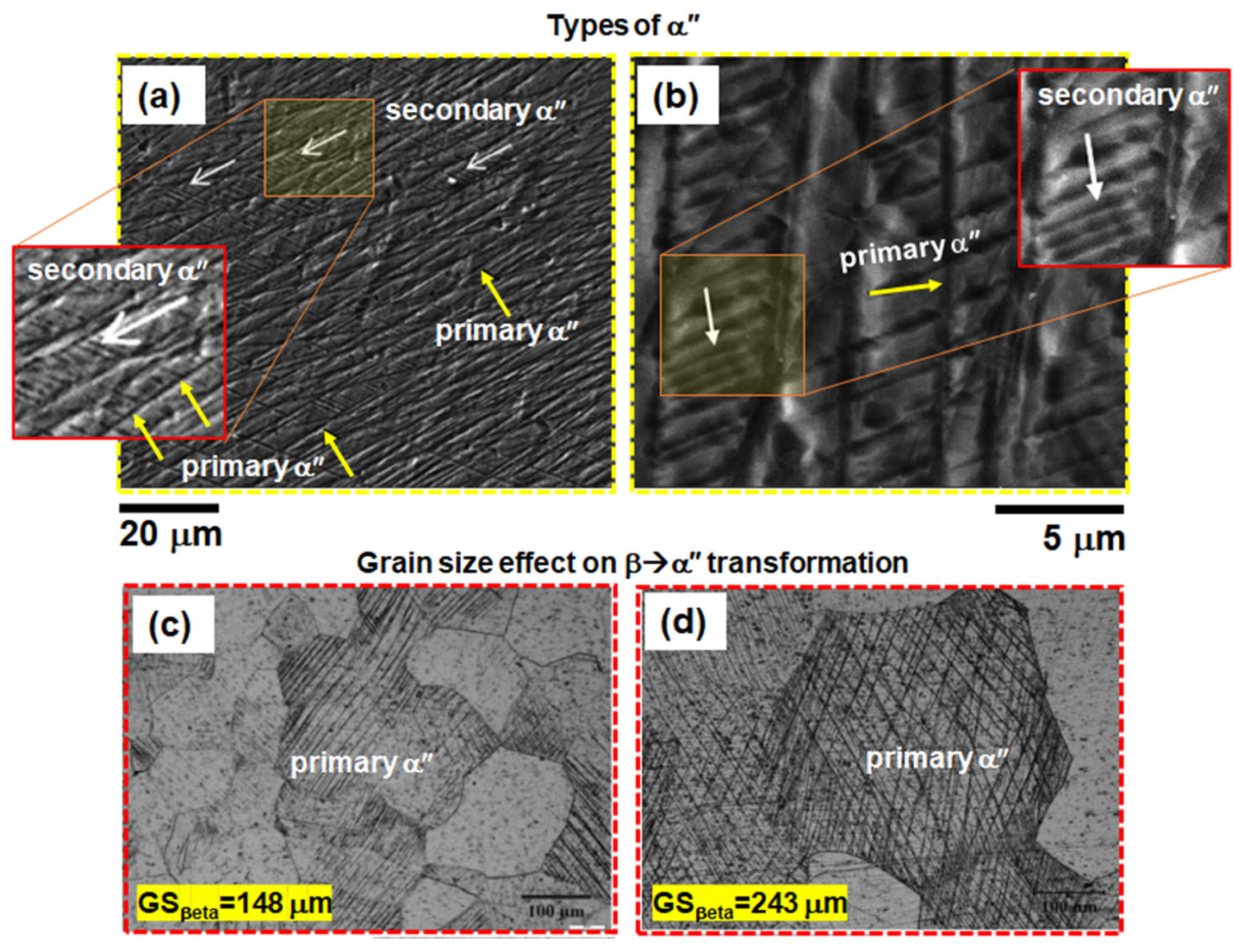
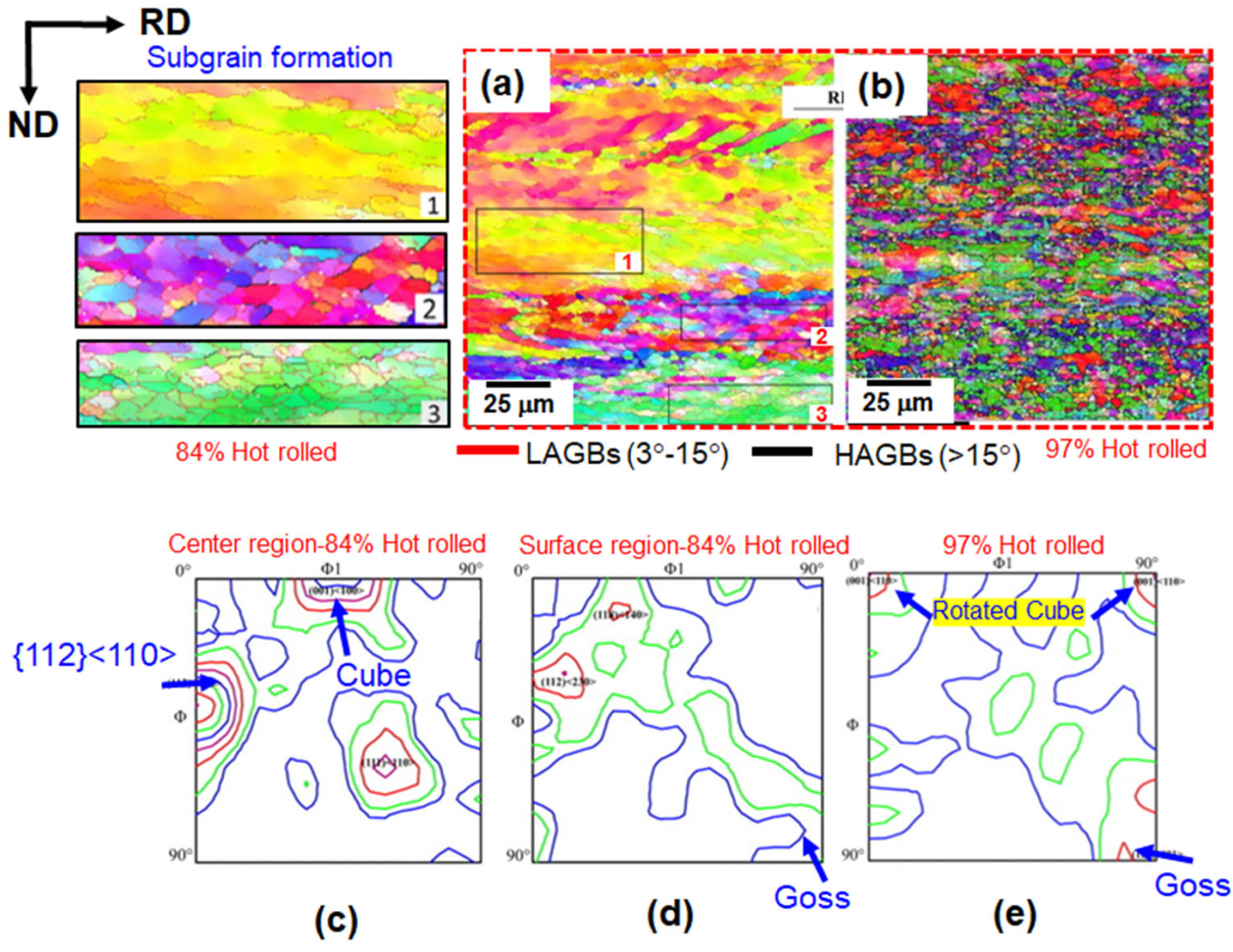
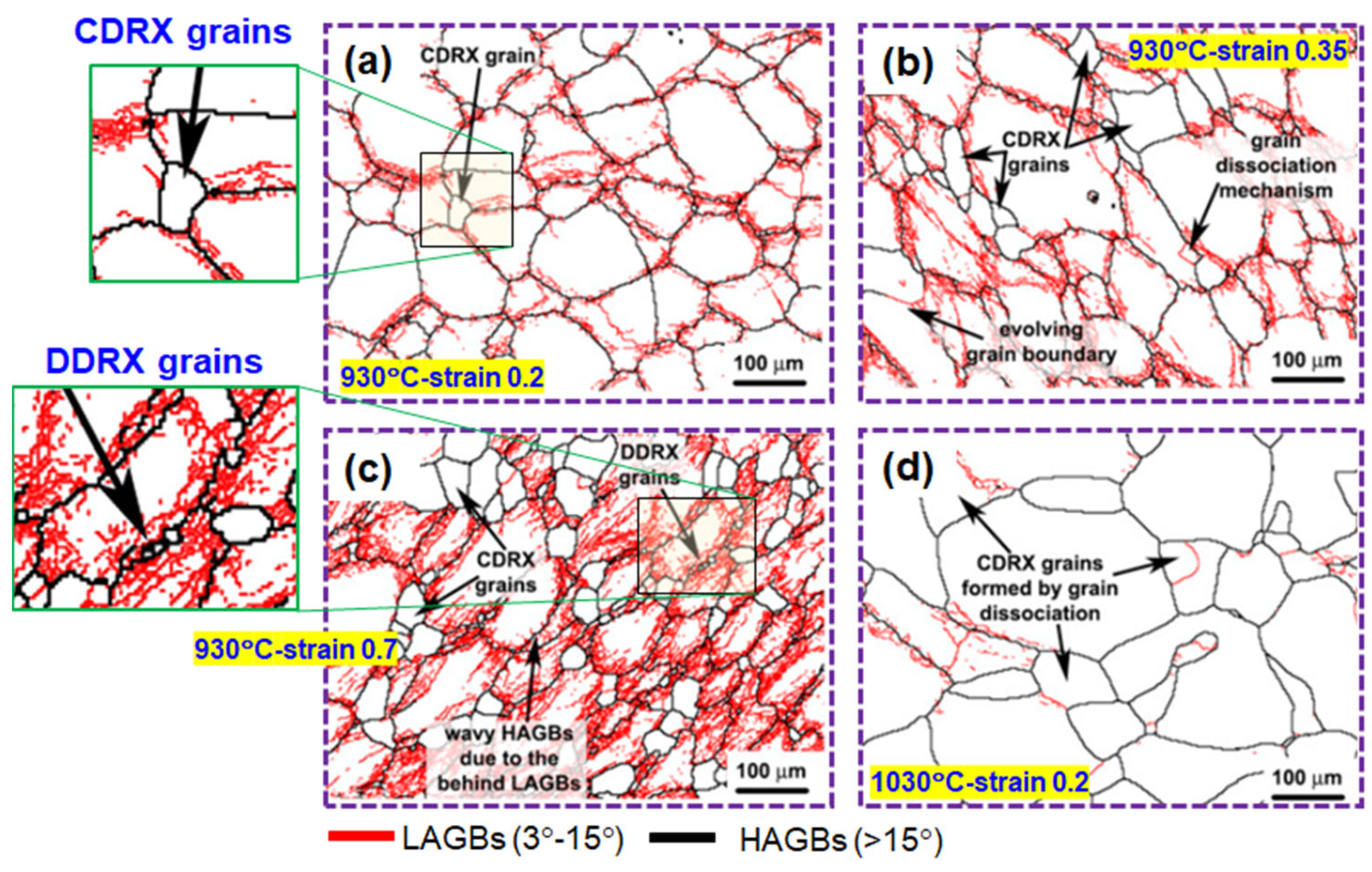

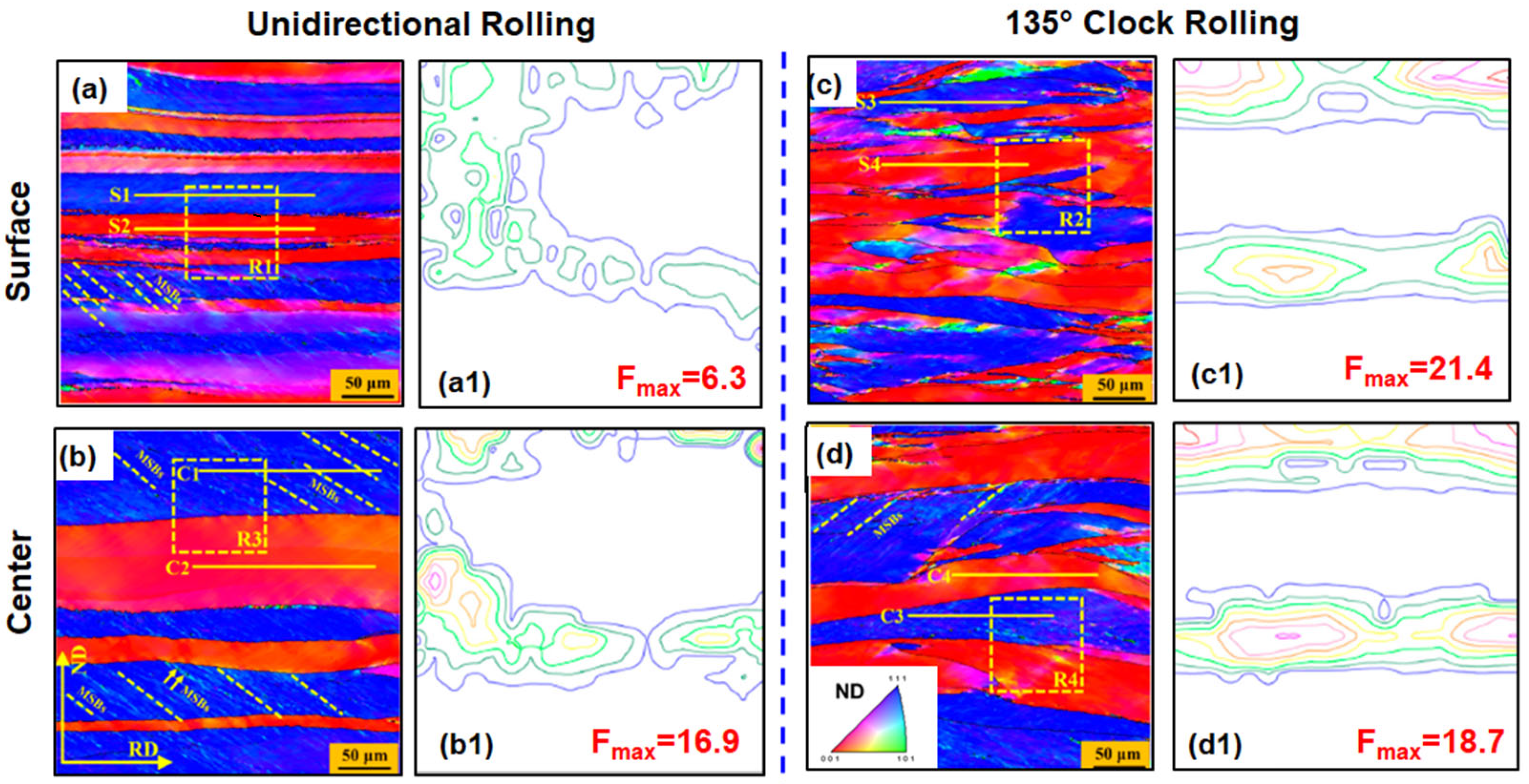
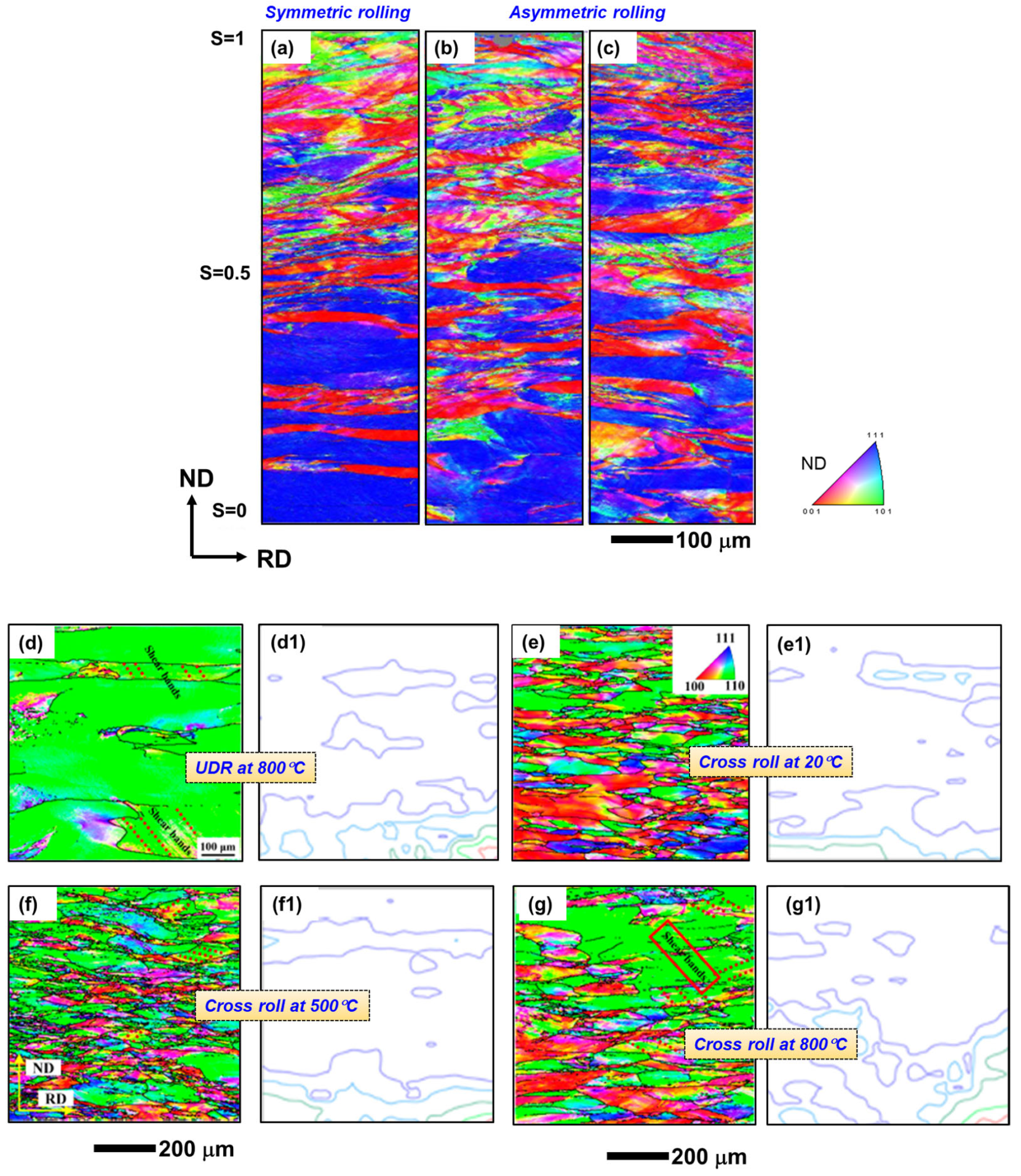
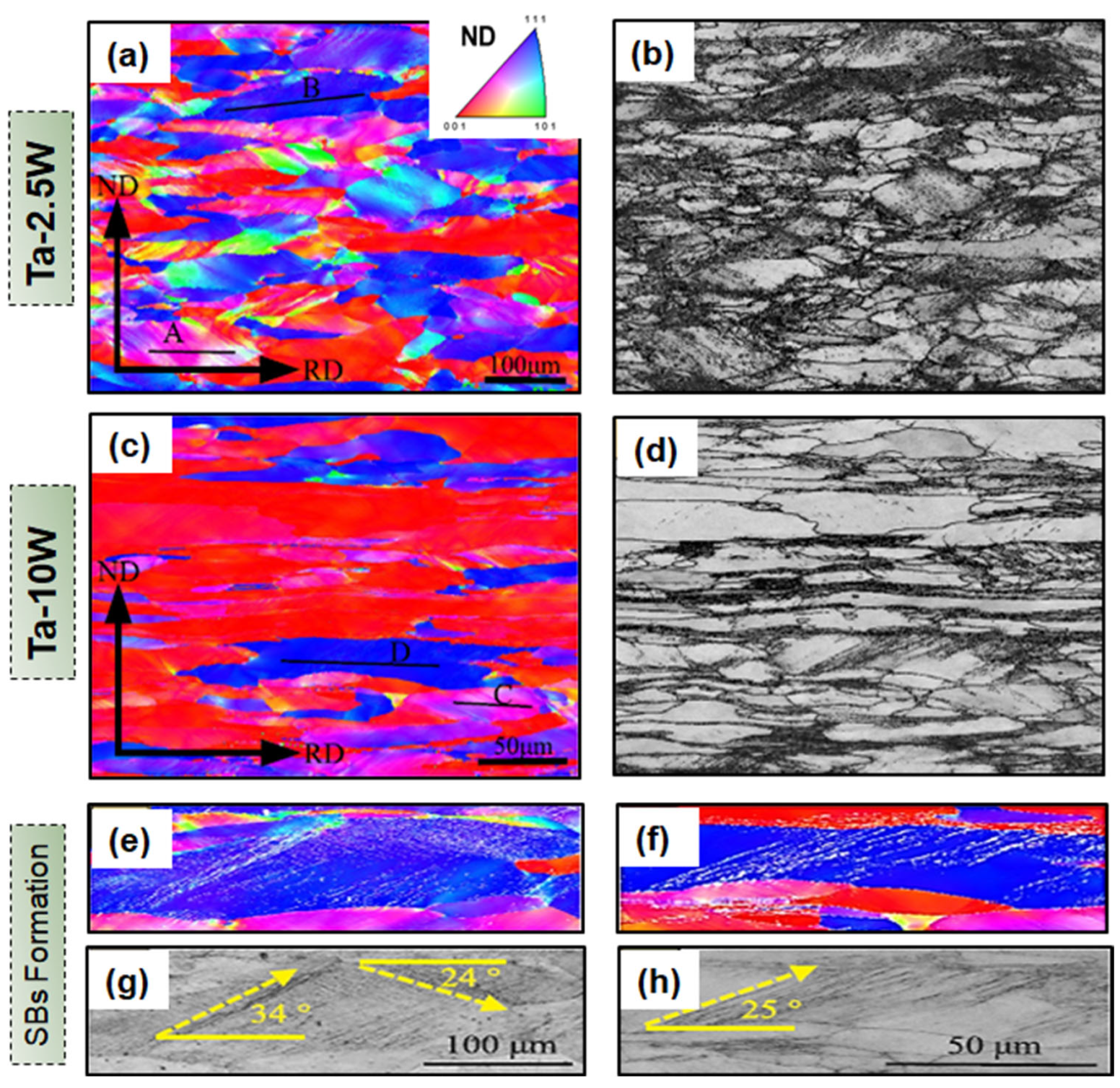
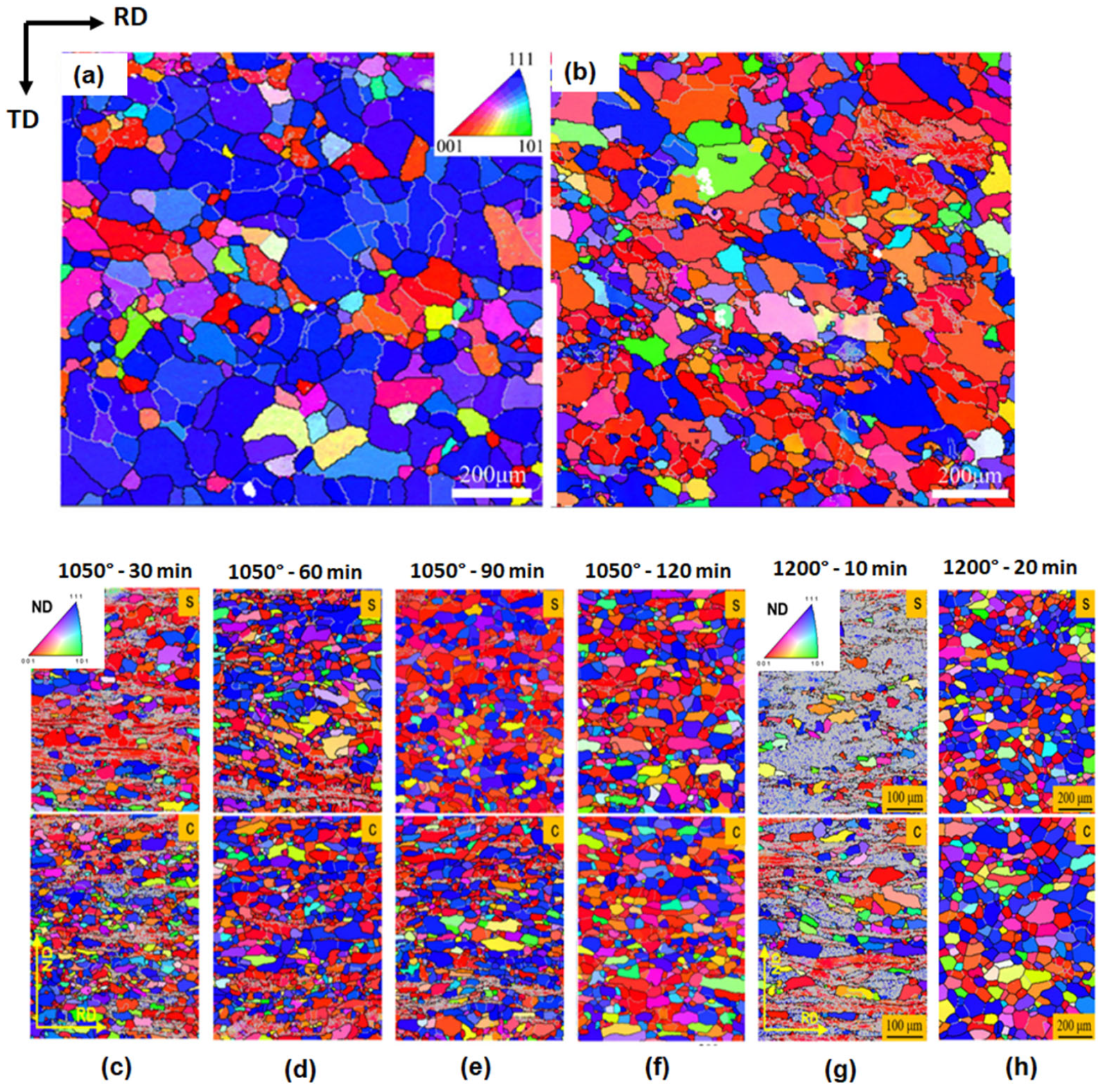
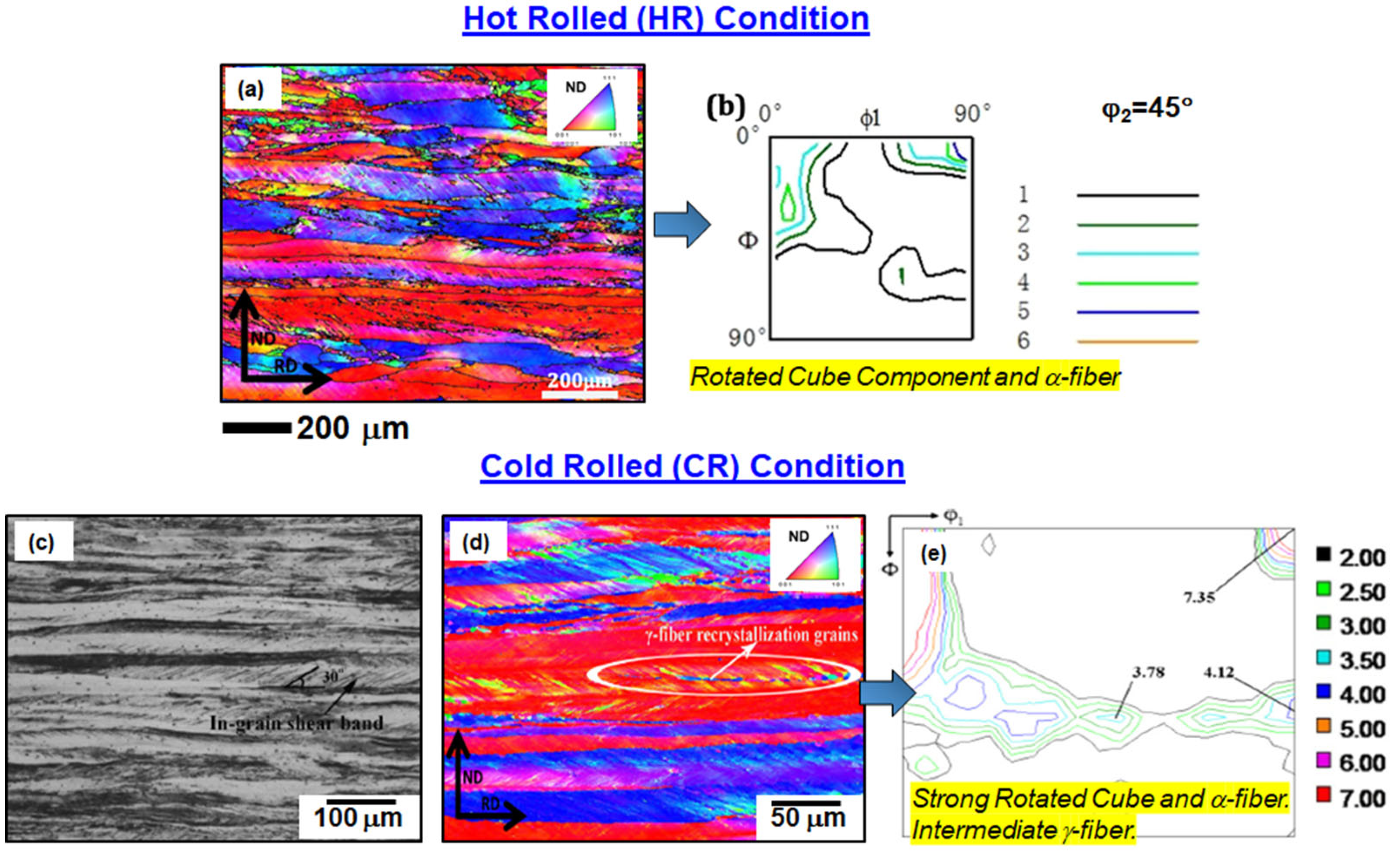
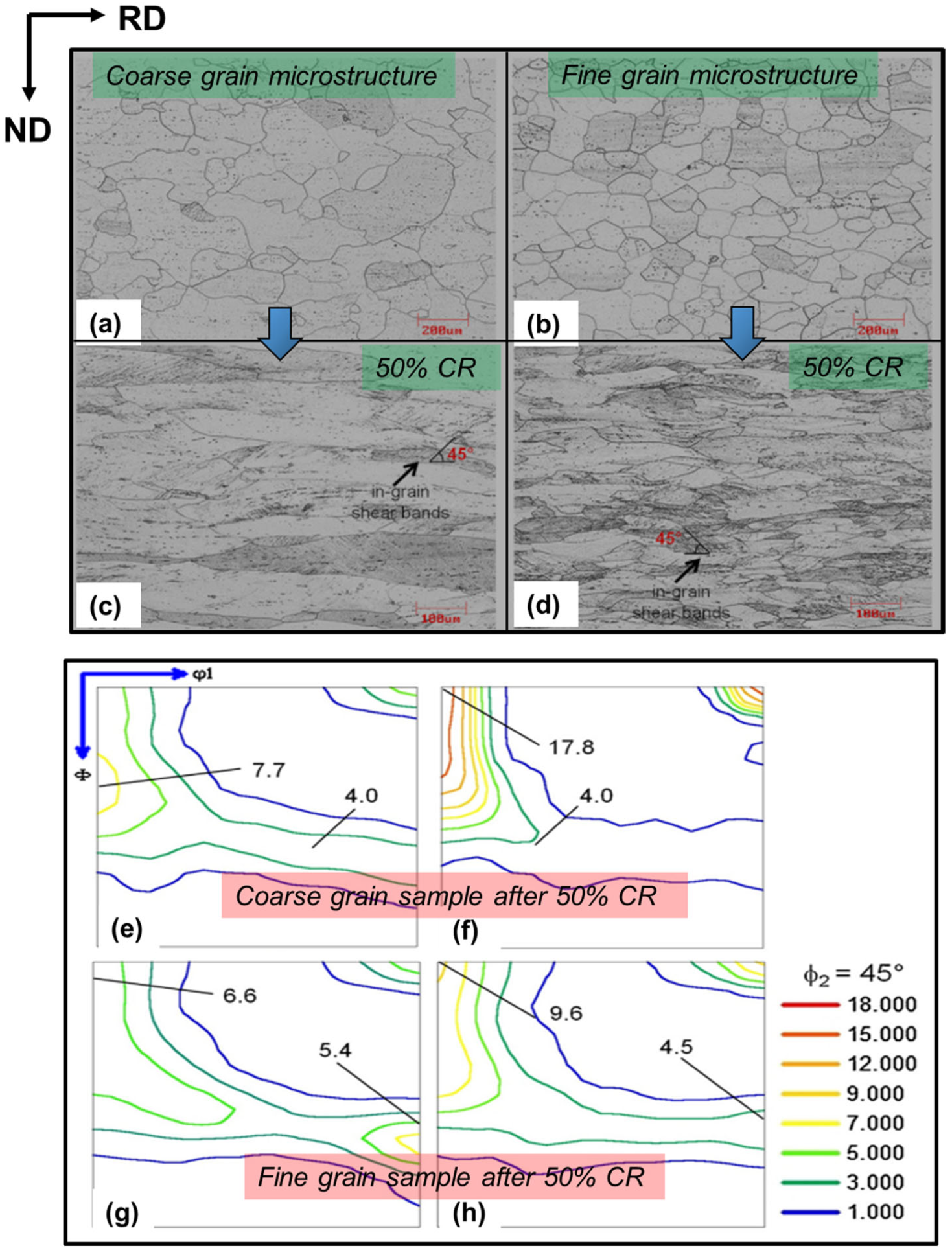
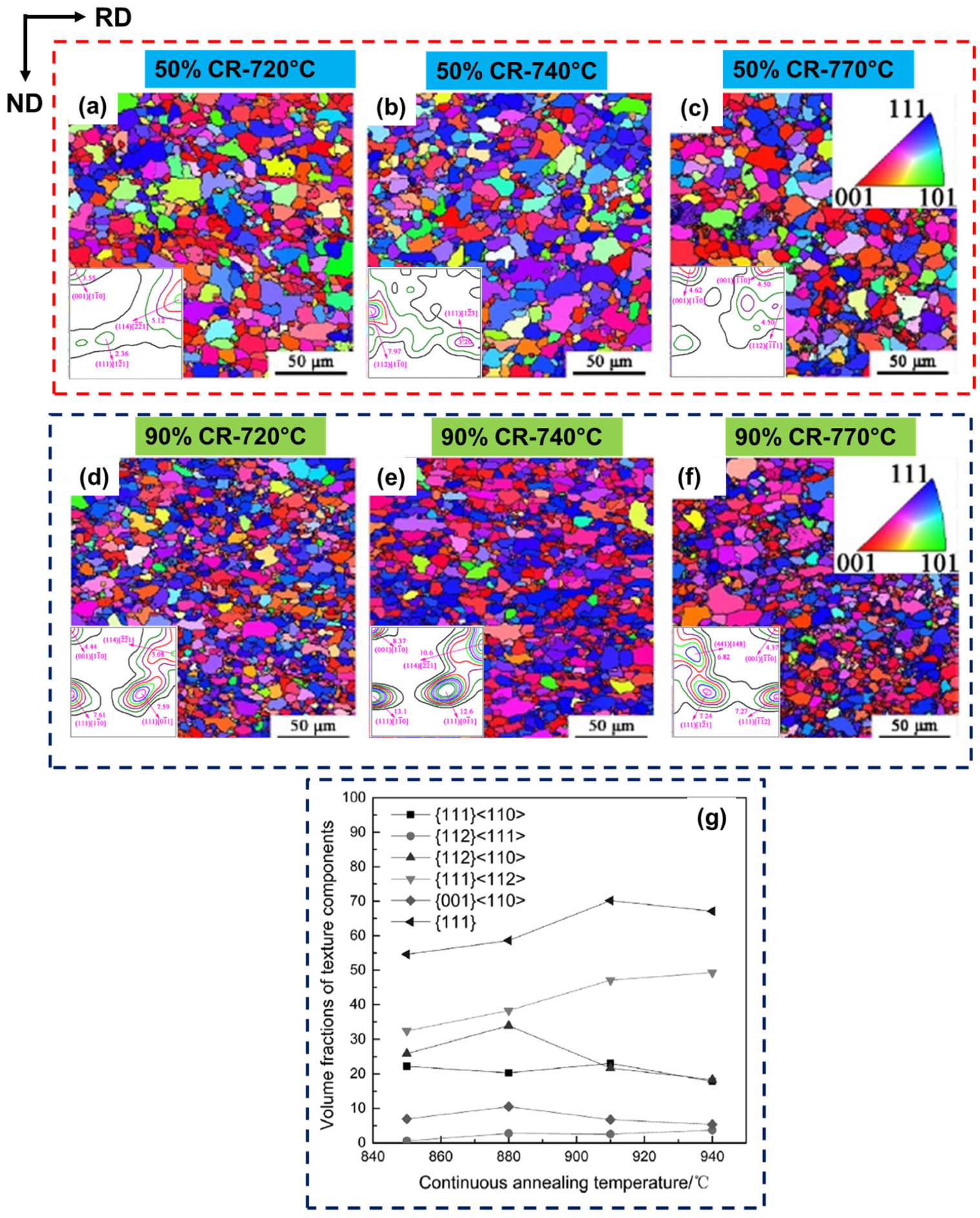
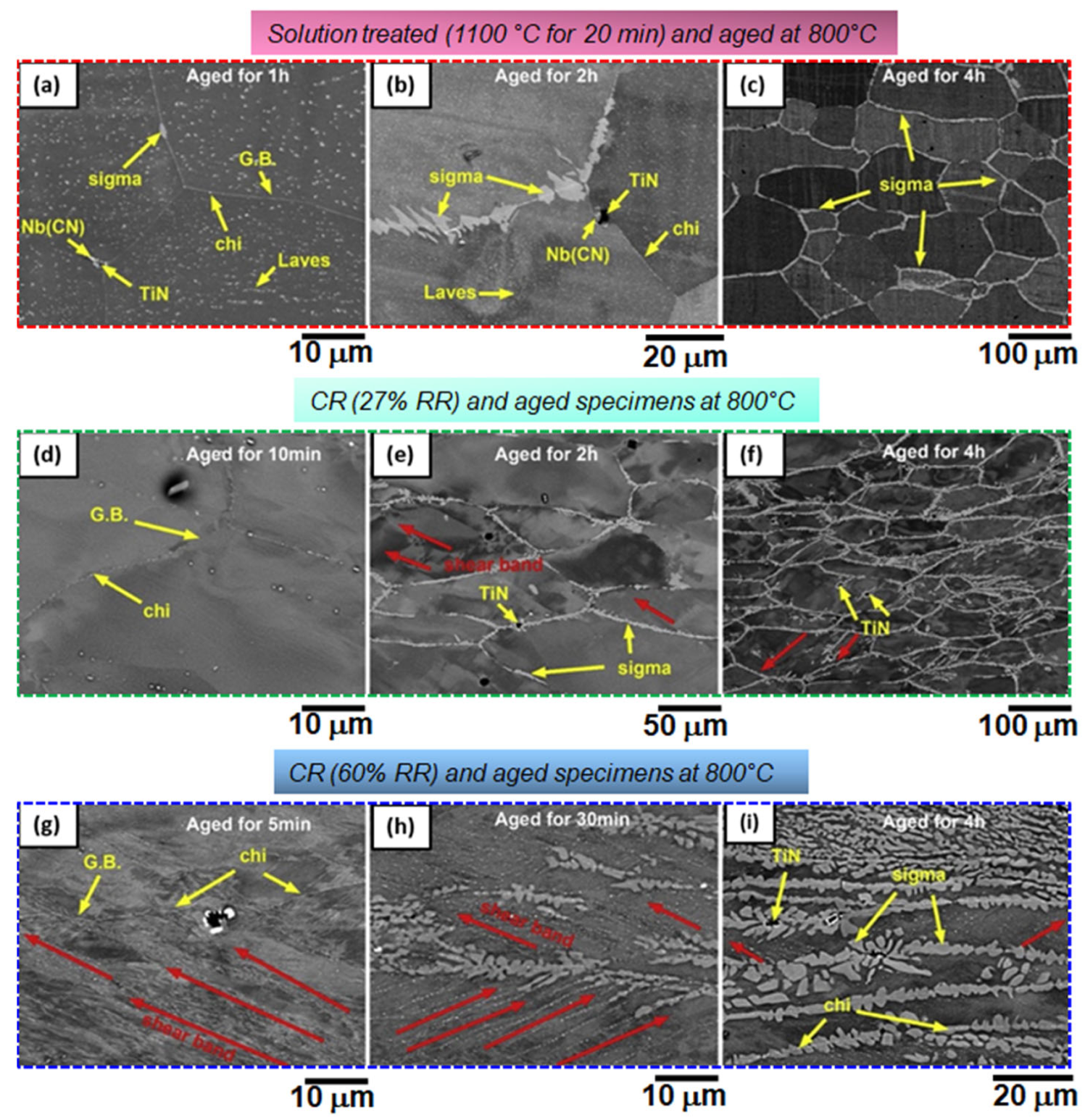
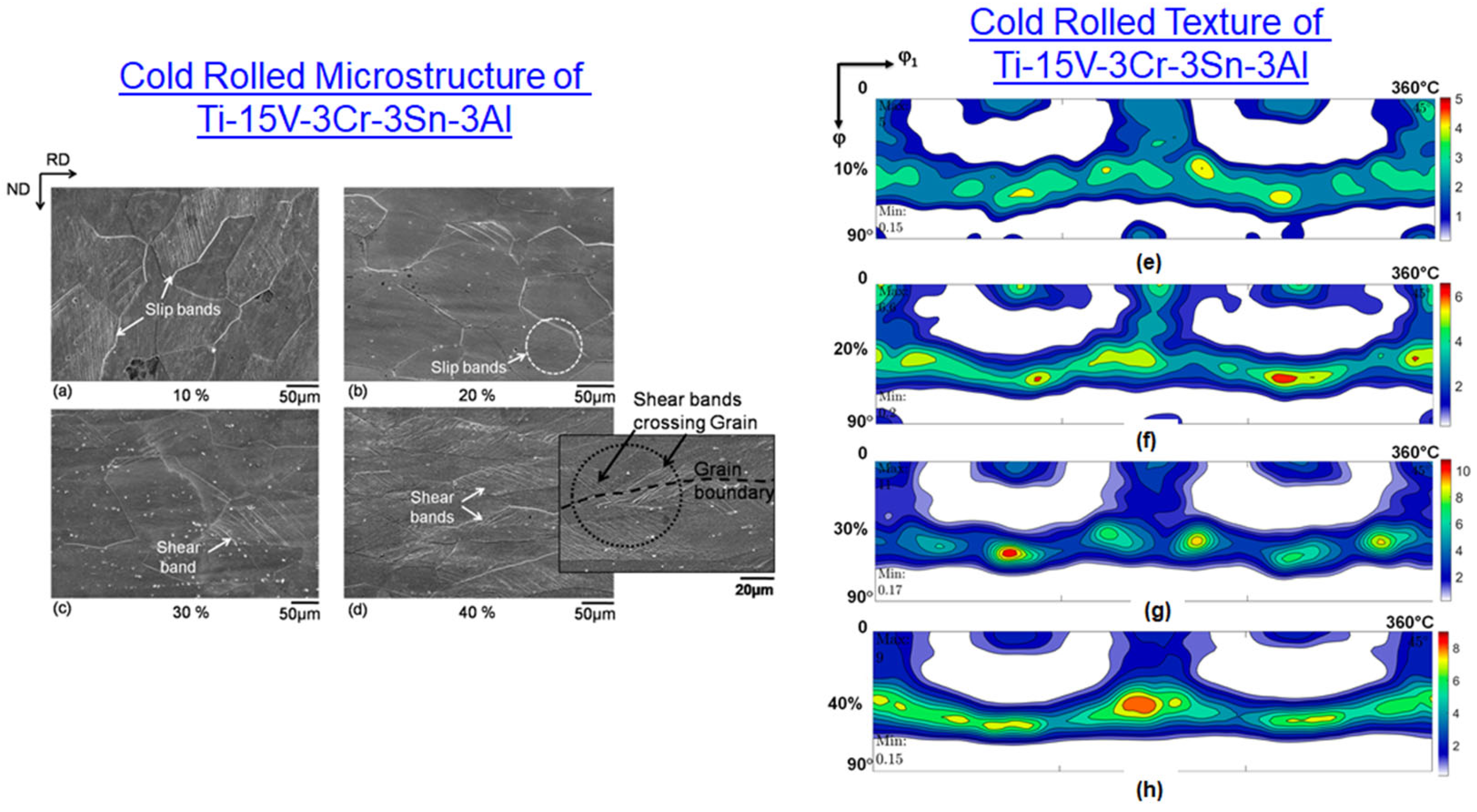
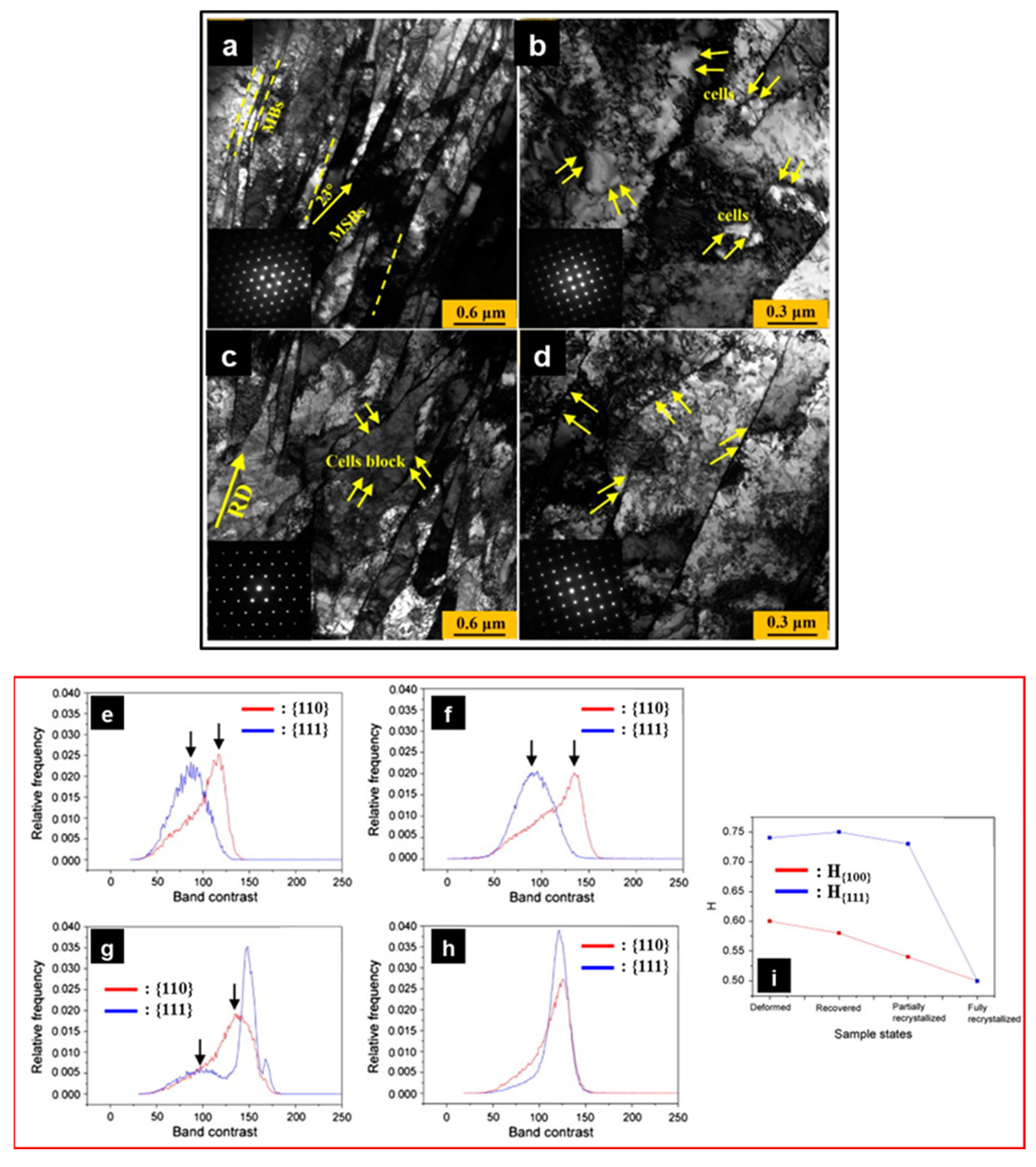

Disclaimer/Publisher’s Note: The statements, opinions and data contained in all publications are solely those of the individual author(s) and contributor(s) and not of MDPI and/or the editor(s). MDPI and/or the editor(s) disclaim responsibility for any injury to people or property resulting from any ideas, methods, instructions or products referred to in the content. |
© 2024 by the authors. Licensee MDPI, Basel, Switzerland. This article is an open access article distributed under the terms and conditions of the Creative Commons Attribution (CC BY) license (https://creativecommons.org/licenses/by/4.0/).
Share and Cite
Tandon, V.; Park, K.-S.; Khatirkar, R.; Gupta, A.; Choi, S.-H. Evolution of Microstructure and Crystallographic Texture in Deformed and Annealed BCC Metals and Alloys: A Review. Metals 2024, 14, 149. https://doi.org/10.3390/met14020149
Tandon V, Park K-S, Khatirkar R, Gupta A, Choi S-H. Evolution of Microstructure and Crystallographic Texture in Deformed and Annealed BCC Metals and Alloys: A Review. Metals. 2024; 14(2):149. https://doi.org/10.3390/met14020149
Chicago/Turabian StyleTandon, Vipin, Ki-Seong Park, Rajesh Khatirkar, Aman Gupta, and Shi-Hoon Choi. 2024. "Evolution of Microstructure and Crystallographic Texture in Deformed and Annealed BCC Metals and Alloys: A Review" Metals 14, no. 2: 149. https://doi.org/10.3390/met14020149
APA StyleTandon, V., Park, K.-S., Khatirkar, R., Gupta, A., & Choi, S.-H. (2024). Evolution of Microstructure and Crystallographic Texture in Deformed and Annealed BCC Metals and Alloys: A Review. Metals, 14(2), 149. https://doi.org/10.3390/met14020149







